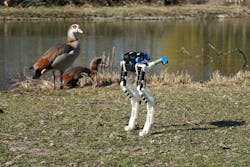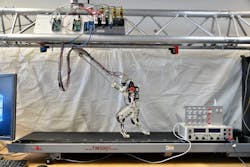A few facts about ostriches: It took just a few million years for terrestrial birds to refine their bipedal locomotor technique. Having mastered the ability to walk and run on two rear limbs, these birds can clock up to 45 mph and can run a 26.2-mile marathon in about 35 min.
Like nature, engineers mold and evolve their designs to meet evolving mechanical needs. Some even look to nature to inspire mechanical design.
A clue to the outstanding locomotor performance of an ostrich is thought to be enabled by the animal’s leg structure, according to researchers at the Max Planck Institute for Intelligent Systems (MPI-IS), based in Stuttgart, Germany.
The researchers have designed robot legs that run on fewer motors than comparable machines and could, theoretically, scale to large size. Their energy-efficient robotic model, called BirdBot, challenges “the reliance on rapid feedback control for joint coordination and replaces active control with intrinsic, mechanical coupling, reminiscent of a self-engaging and disengaging clutch,” they noted.
The innovation behind the design is the collaborative efforts of Alexander Badri-Spröwitz and Alborz Aghamaleki Sarvestani of International Max Planck Research School for Intelligent Systems (IMPRS-IS); the roboticist Metin Sitti, a director at MPI-IS; and biology professor Monica A. Daley of the University of California, Irvine. Their paper was published in the journal Science Robotics.
Coupled Mechanics
When walking, birds differ from humans in that they pull their legs up towards their bodies in the swing phase. It turns out there’s efficiency built into the function of this movement.
The researchers attribute this movement to a mechanical coupling. “It’s not the nervous system, it’s not electrical impulses, it’s not muscle activity,” explained Badri-Spröwitz, who leads the Dynamic Locomotion Group at IMPRS-IS and has spent five years exploring questions related to why avian foot movement patterns might be energy-efficient for walking and running.
“We hypothesized a new function of the foot-leg coupling through a network of muscles and tendons that extends across multiple joints,” said Badri-Spröwitz. “These multi-joint muscle-tendon coordinate foot folding in the swing phase. In our robot, we have implemented the coupled mechanics in the leg and foot, which enables energy-efficient and robust robot walking. Our results demonstrating this mechanism in a robot lead us to believe that similar efficiency benefits also hold true for birds.”
The researchers speculated that the reason a large animal like an ostrich is able to run at high speeds and stand without tiring can be attributed to the coupling of the leg and foot joints and the forces and movements involved. A person who weighs 220 lb, noted the researchers, is able to stand on their legs for long periods of time with their knees “locked” in an extended position. This function becomes strenuous when the person squats slightly.
In contrast, they noted, the bent stance seems to be a moot point to the leg structure of birds. In fact, many birds sleep while standing in an upright position.
Badri-Spröwitz and his team, who work at the interface of biology and robotics in the field of biomechanics and neurocontrol, considered ways to mimic the flightless bird’s posture and movement, with the objective of uncovering a solution where no motor power should be needed to keep the robot in an upright position.
Running on a Treadmill
The team’s robotic bird leg model was designed without motors in the foot. The leg of their robot features a joint equipped with a spring and cable mechanism. The foot is mechanically coupled to the rest of the leg’s joints through cables and pulleys, they explained. A motor in the hip joint swings the leg back and forth, while a small motor flexes the knee joint to pull the leg up.
Testing the BirdBot on a treadmill, they determined that the foot and leg joints did not need actuation while standing.
“Springs power these joints, and the multi-joint spring-tendon mechanism coordinates joint movements,” said Badri-Spröwitz. “When the leg is pulled into swing phase, the foot disengages the leg’s spring. Compare this to the muscle-tendon spring, as it occurs in animals.”
In stationary mode, the robotic leg expends zero energy. The researchers explained that in previous iterations, the robot had to work against the spring. Alternatively, a motor would be needed for standing or lifting the leg while preventing it from dragging during a swing.
The new configuration requires about a quarter of the energy of predecessors, said Aghamaleki Sarvestani.
In running mode on the treadmill, the robot’s foot effectively disengages the leg’s spring in each swing phase. The researchers explained that the large foot movement slacks the cable, while the other leg joints swing loosely. This motion is typically facilitated by a motor at the joint, they said. Sensors manage the on/off signalling to the robot’s motors.
"Previously, motors were switched depending on whether the leg was in the swing or stance phase,” said Badri-Spröwitz. “Now the foot takes over this function in the walking machine, mechanically switching between stance and swing. We only need one motor at the hip joint and one motor to bend the knee in the swing phase. We leave leg spring engagement and disengagement to the bird-inspired mechanics. This is robust, fast and energy-efficient.”
Robots Confirm Hypotheses from Biology
The research includes observations about the way morphological intelligence is built into the system that allows the animal to act quickly. It is not always the animal’s sense of touch or sight that comes into play, according to Monica Daley, whose previous research has shown that birds respond more rapidly than the nervous system allows, indicating mechanical contributions to control.
“The [robotic] structure with its multi-jointed muscle-tendons and its unique foot movement can explain why even heavy, large birds run so quickly, robustly and energy-efficient,” said Daley. “If I assume that everything in the bird is based on sensing and action, and the animal steps onto an unexpected obstacle, the animal might not be able to react quickly enough. Perception and sensing, even the transmission of the stimuli and the reaction, cost time.”
The robot demonstrates how these mechanisms work and helps to confirm the animal’s robust ability to switch mechanically if there is an obstacle in the way, said the researchers.
BirdBot paves the way for scaling. In theory, according to the research team, meter-high legs can be developed to carry robots with the weight of several tons that walk around with little power input.
View the BirdBot walking in the research group’s laboratory:
About the Author

Rehana Begg
Editor-in-Chief, Machine Design
As Machine Design’s content lead, Rehana Begg is tasked with elevating the voice of the design and multi-disciplinary engineer in the face of digital transformation and engineering innovation. Begg has more than 24 years of editorial experience and has spent the past decade in the trenches of industrial manufacturing, focusing on new technologies, manufacturing innovation and business. Her B2B career has taken her from corporate boardrooms to plant floors and underground mining stopes, covering everything from automation & IIoT, robotics, mechanical design and additive manufacturing to plant operations, maintenance, reliability and continuous improvement. Begg holds an MBA, a Master of Journalism degree, and a BA (Hons.) in Political Science. She is committed to lifelong learning and feeds her passion for innovation in publishing, transparent science and clear communication by attending relevant conferences and seminars/workshops.
Follow Rehana Begg via the following social media handles:
X: @rehanabegg
LinkedIn: @rehanabegg and @MachineDesign


